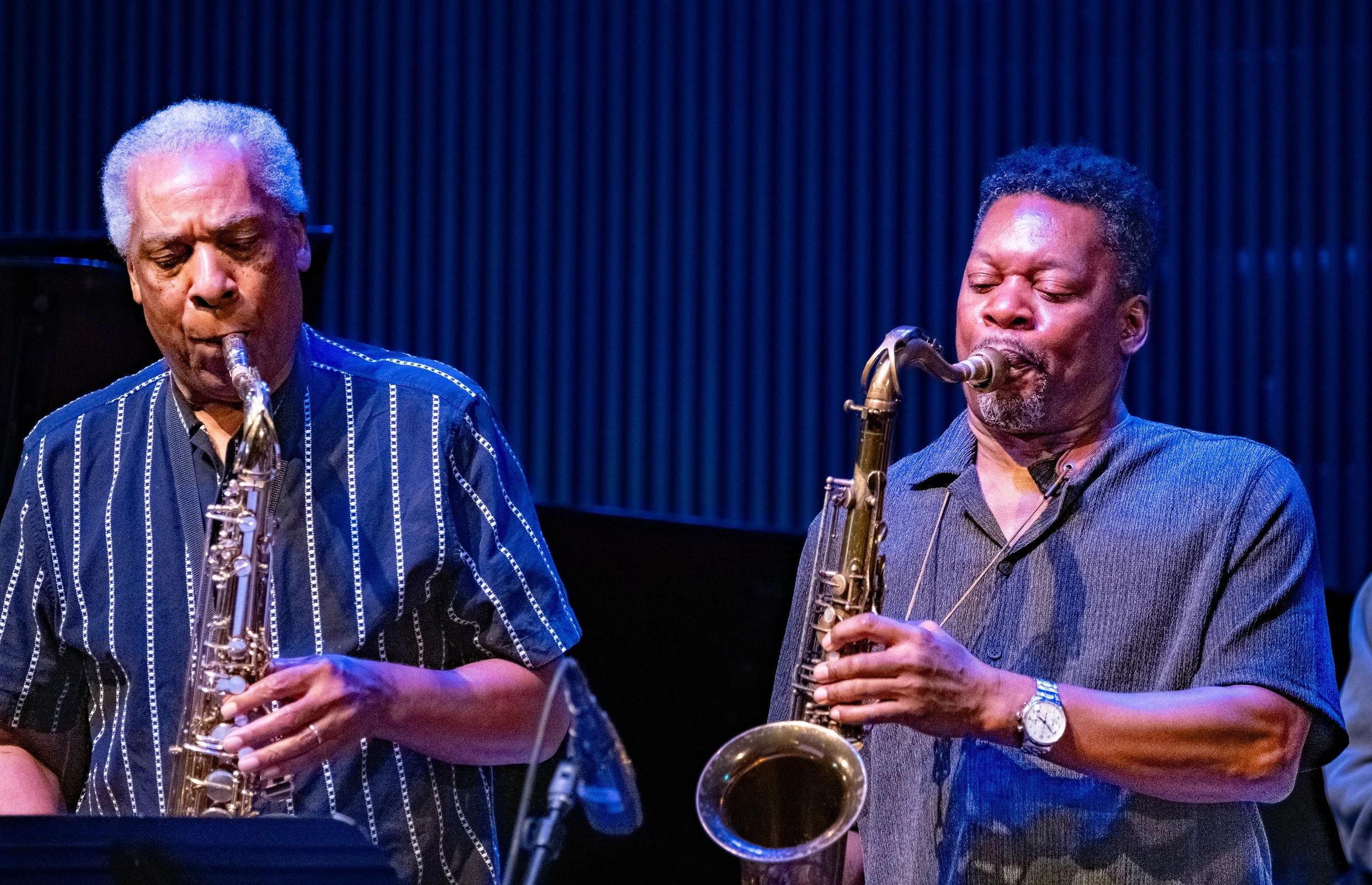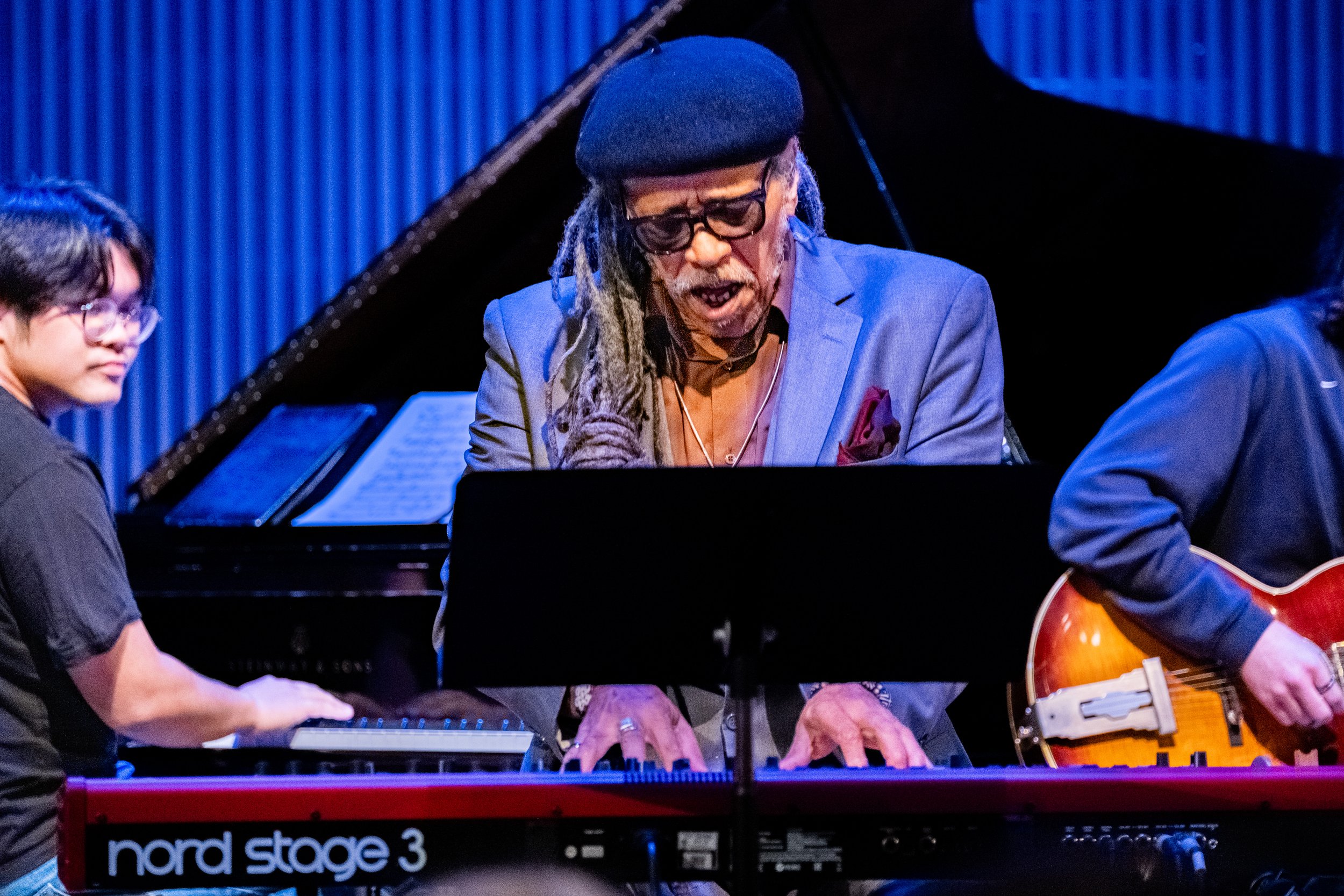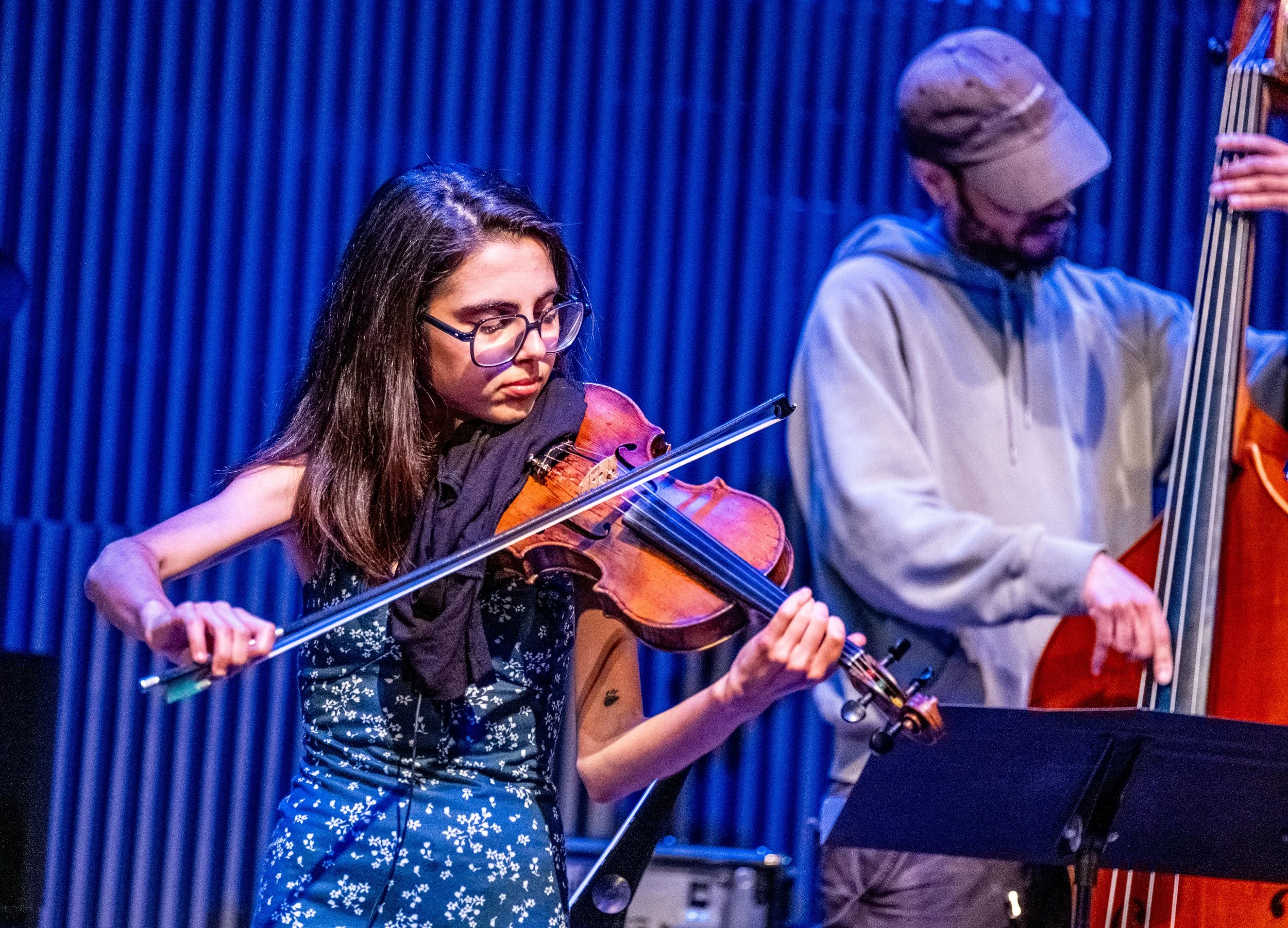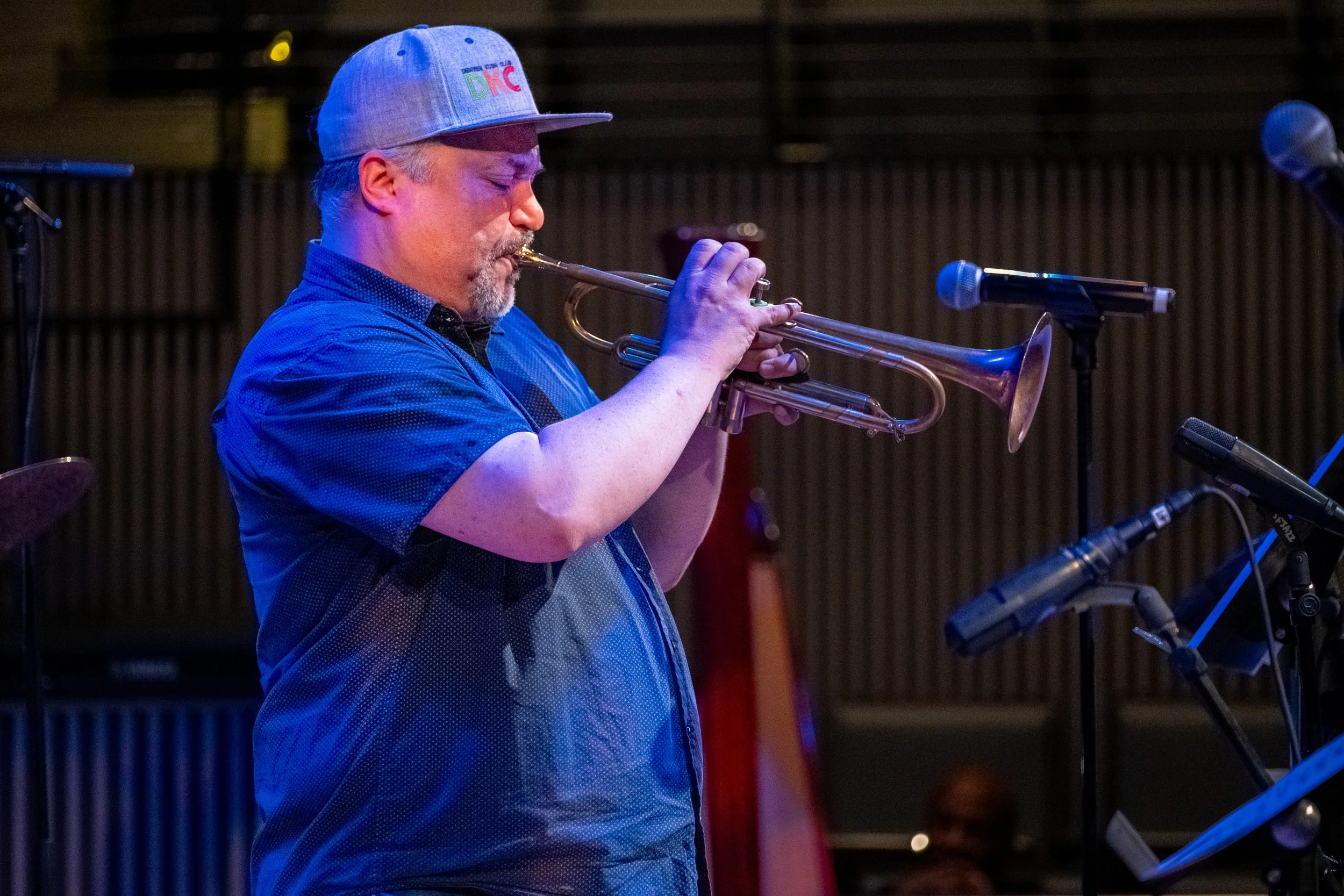Giant Steps for Everybody: Ravi Coltrane’s Communal Voyage at SFJAM
Ravi Coltrane (right) with a jam session attendee
Miner Auditorium felt less like a concert hall and more like an open‑air workshop on July 28, when saxophonist and resident artistic director Ravi Coltrane invited the Bay Area to step onto the same stage where, moments earlier, he and his house band—pianist Sundra Manning, bassist Gary Brown, and drummer Elé Howell—had been shaping Coltrane family repertoire into fresh clay. By the time the two‑hour “SFJAM: Free Community Jam Session Featuring the Music of Alice & John Coltrane” was underway, instrument cases lined stage right like eager suitcases at a train depot, while Rebeca Mauleón, SFJAZZ’s Director of Education, reminded the crowd that the afternoon was “for sharing, listening, and learning—so make space, make music, and most of all, make friends.”
That invitation set the tone for an afternoon that blurred generational and genre lines. Coltrane’s own words from earlier in the week—“leave some room for possibilities… it’s about staying in the moment with the music”—hung in the air as the first tune, “Equinox,” took shape. Two college-aged horn players, a determined middle‑schooler clutching a rented alto, and a silver‑templed trumpeter shuffled into place beside Ravi. After a brief flurry of chord‑chart consultations (and one sheepish drummer retreating with an “I don’t know that one”), the ad‑hoc front line settled into McCoy Tyner’s nocturnal changes. Each solo was met with polite cheers, but it was Coltrane’s grin—equal parts mentor and proud parent—that sealed the deal: the jam session had officially left the station.
If “Equinox” warmed up the room, “Central Park West” opened the floodgates. A keyboardist with waist-length gray dreads floated a pastel reharmonization before migrating to a Nord Stage 3 for a decidedly electric detour. Coltrane stood off to the side, index finger conducting traffic, yet never policing the music. The jammers listened, responded, and, when necessary, stumbled together—learning in real time that trust is the secret currency of improvisation.
Harpist Destiny Muhammad
More musicians continued to arrive, and the stage began to resemble an overenthusiastic family reunion. A harp—a seldom-seen guest at jazz jams—rolled on for Alice Coltrane’s “Journey” and “Blue Nile,” its luminous glissandi framing gentle modal explorations from flute and guitar. The sight of nylon strings and orchestral pedals under Miner Auditorium’s lights drew a collective hush; even the rhythm section thinned to a heartbeat pulse so the harpist’s cascading arpeggios could shimmer unhurried.
The mood shifted gears with “Bessie’s Blues.” Brown relinquished his bass to a lanky teenager in Doc Martens, and Manning ceded the piano bench to a t-shirted jammer whose back sported a white cartoon cat. What could have been chaos turned into a call‑and‑response clinic: five horns, including a slide trombone, volleyed bluesy riffs while the La Peña‑tee‑wearing drummer punctuated each chorus with polyrhythmic snaps. Coltrane, standing stage left, laughed into his ligature when the trombonist quoted “A Night in Tunisia”—the kind of inside joke that makes a jam session feel like a living archive.
Next came the litmus test: “Giant Steps.” When Coltrane asked who felt brave, three saxophonists, a trumpeter, a bassist, a pianist, and a guitarist rose. A former flautist re-emerged brandishing a tenor; clearly, word had spread that the changes were about to accelerate. Coltrane cued the downbeat, then let go completely. Lines skittered, pivoted, doubled back—sometimes colliding—but whenever someone lost the harmonic thread, another player nudged them back on course. Watching the younger musicians trade eights with seasoned veterans felt less like an apprenticeship and more like a conversation that politely ignored age.
Joanna, a violinist from Portugal, attended the afternoon jam session.
Then came “Impressions,” and with it, the evening’s breakout star: Joanna, a 28-year-old violinist visiting from Portugal. Elbow angled high, she sketched the modal melody in warm, woody strokes, the bow dancing above a drummer’s cymbal wash. A murmur rippled through the seating rows as listeners realized they were witnessing a first in Miner Auditorium: a violinist fronting a Coltrane tune at a community jam. Coltrane nodded appreciatively, weaving obbligato phrases behind her solo like a master tailor hemming a new garment. The ovation was instantaneous.
Throughout the afternoon, Mauleón acted as genial traffic cop, her mic announcements keeping things moving (“Trumpets, you’re up next—saxes, get ready!”). She also made sure the complementary beverage table received due credit, joking that hydration was “the fifth instrument in every good session.” The levity mattered; with nearly forty musicians cycling through the lineup, small moments of laughter kept the focus on cooperation over competition.
Tumpeter Mike Olmos
The finale, “Locomotion,” brought the house band back for a victory lap along with trumpet‑jammer Mike Olmos, whose brassy swagger threaded through the head before the melody dissolved into a free‑for‑all of traded fours. Howell’s drums erupted into rolling thunder, Manning splashed clusters across the keys, and Coltrane, headset mic askew, sounded like a joyous referee blowing the whistle at a playground: organized pandemonium in the best sense. The last chord rang, cymbals sizzled, and, for a beat, nobody moved. Then the entire stage—harpist, violinist, gray‑dreaded pianist, teenage bassist, slide trombonist, and all—dissolved into handshakes and hugs.
In a city where ticket prices can make live jazz feel out of reach, SFJAZZ’s decision to throw its doors open monthly is more than community outreach; it’s cultural stewardship. Miner Auditorium is among the country’s most pristine rooms, yet for two free-form hours, it became the kind of neighborhood jam many musicians first cut their teeth on—just with better acoustics and a world-class house band. Coltrane may have been the featured talent on the afternoon’s show, but the real star was the promise that anyone, given a little courage and a well-tuned horn, could share the stage with him.
That promise will continue this fall, when SFJAM relocates to the more intimate Joe Henderson Lab. Space will be limited, Mauleón warned, but the spirit— “show up, sign up, and let the music teach you”—will remain. Monday afternoon proved that such sessions aren’t merely extracurricular; they’re essential, organic classrooms where tradition is handed down not by lecture but by listening and leaping.
Walking out of Miner, one couldn’t help recalling Coltrane’s earlier musing about “arriving somewhere unexpected.” Every musician, from harpist Destiny Muhammad spinning Alice’s celestial harmonies to the teenage saxophonist wrestling “Giant Steps” changes, had arrived in a new place—lifted by a community that values possibilities over perfection. And that, perhaps, is the most lasting impression of all.





